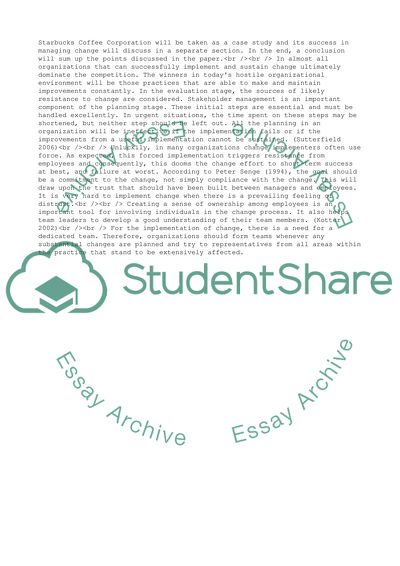Cite this document
(Managing Change: Starbucks Coffee Corporation Case Study, n.d.)
Managing Change: Starbucks Coffee Corporation Case Study. Retrieved from https://studentshare.org/management/1566485-managing-change-with-reference-to-relevant-theories-and-empirical-data-discuss-the-major-issues-involved-in-either-a-the-generation-of-change-in-organisations-or-b-change-implementation-critically-examine-how-power-might-be-used-and-to-what-effect
Managing Change: Starbucks Coffee Corporation Case Study. Retrieved from https://studentshare.org/management/1566485-managing-change-with-reference-to-relevant-theories-and-empirical-data-discuss-the-major-issues-involved-in-either-a-the-generation-of-change-in-organisations-or-b-change-implementation-critically-examine-how-power-might-be-used-and-to-what-effect
(Managing Change: Starbucks Coffee Corporation Case Study)
Managing Change: Starbucks Coffee Corporation Case Study. https://studentshare.org/management/1566485-managing-change-with-reference-to-relevant-theories-and-empirical-data-discuss-the-major-issues-involved-in-either-a-the-generation-of-change-in-organisations-or-b-change-implementation-critically-examine-how-power-might-be-used-and-to-what-effect.
Managing Change: Starbucks Coffee Corporation Case Study. https://studentshare.org/management/1566485-managing-change-with-reference-to-relevant-theories-and-empirical-data-discuss-the-major-issues-involved-in-either-a-the-generation-of-change-in-organisations-or-b-change-implementation-critically-examine-how-power-might-be-used-and-to-what-effect.
“Managing Change: Starbucks Coffee Corporation Case Study”. https://studentshare.org/management/1566485-managing-change-with-reference-to-relevant-theories-and-empirical-data-discuss-the-major-issues-involved-in-either-a-the-generation-of-change-in-organisations-or-b-change-implementation-critically-examine-how-power-might-be-used-and-to-what-effect.


